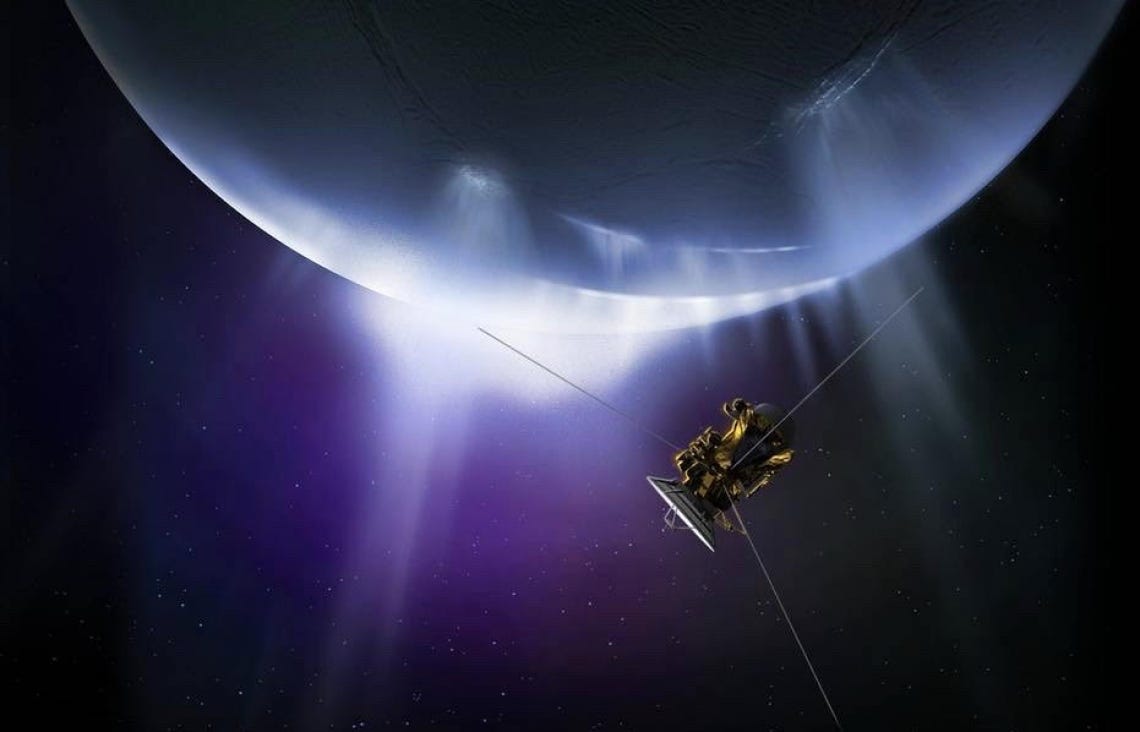Scientists predict the discovery of life on Saturn’s icy moon Enceladus
The mystery of whether microbial alien life might inhabit Enceladus, one of Saturn’s 83 moons, could be solved by an orbiting space probe.

[Dec. 25, 2022: Daniel Stolte, University of Arizona]
Artist's impression of the Cassini spacecraft flying through plumes erupting from the south pole of Saturn's moon Enceladus. These plumes are much like geysers and expel a combination of water vapor, ice grains, salts, methane and other organic molecules. (CREDIT: NASA/JPL-Caltech)
The mystery of whether microbial alien life might inhabit Enceladus, one of Saturn's 83 moons, could be solved by an orbiting space probe, according to a new study led by University of Arizona researchers. In a paper published in The Planetary Science Journal, the researchers map out how a hypothetical space mission could provide definite answers.
When Enceladus was initially surveyed in 1980 by NASA's Voyager 1 spacecraft, it looked like a small, not overly exciting "snowball" in the sky. Later, between 2005 to 2017, NASA's Cassini probe zipped around the Saturnian System and studied Saturn's complex rings and moons in unprecedented detail. Scientists were stunned when Cassini discovered that Enceladus' thick layer of ice hides a vast, warm saltwater ocean outgassing methane, a gas that typically originates from microbial life on Earth.
The methane, along with other organic molecules that build the foundations of life, were detected when Cassini flew through giant water plumes erupting from the surface of Enceladus. As the tiny moon orbits the ringed gas giant, it is being squeezed and tugged by Saturn's immense gravitational field, heating up its interior due to friction. As a result, spectacular plumes of water jet from cracks and crevices on Enceladus' icy surface into space.
Last year, a team of scientists at UArizona and Université Paris Sciences et Lettres in Paris calculated that if life could have emerged on Enceladus, there is a high likelihood that its presence could explain why the moon is burping up methane.
Related Stories
"To know if that is the case, we must go back to Enceladus and look," said Régis Ferrière, senior author of the new paper and associate professor in the UArizona Department of Ecology and Evolutionary Biology.
In their latest paper, Ferrière and his collaborators report that while the hypothetical total mass of living microbes in Enceladus' ocean would be small, a visit from an orbiting spacecraft is all that would be needed to know for sure whether Earthlike microbes populate Enceladus' ocean underneath its shell.
"Clearly, sending a robot crawling through ice cracks and deep-diving down to the seafloor would not be easy," Ferrière said, explaining that more realistic missions have been designed that would use upgraded instruments to sample the plumes like Cassini did, or even land on the moon's surface.
This graphic depicts how scientists believe water interacts with rock at the bottom of Enceladus’ ocean to create hydrothermal vent systems. These same chimney-like vents are found along tectonic plate borders in Earth’s oceans, approximately 7000 feet below the surface. (CREDIT: NASA/JPL-Caltech/Southwest Research Institute)
"By simulating the data that a more prepared and advanced orbiting spacecraft would gather from just the plumes alone, our team has now shown that this approach would be enough to confidently determine whether or not there is life within Enceladus' ocean without actually having to probe the depths of the moon," he said. "This is a thrilling perspective."
Located about 800 million miles from Earth, Enceladus completes an orbit around Saturn every 33 hours. While the moon isn't even as wide as the state of Arizona, it visually stands out because of its surface; like a frozen pond glinting in the sun, the moon reflects light like no other object in the solar system. Along the moon's south pole, at least 100 giant water plumes erupt through cracks in the icy landscape much like lava from a violent volcano.
Régis Ferrière, senior author of the new paper and associate professor in the UArizona Department of Ecology and Evolutionary Biology.
Scientists believe that water vapor and ice particles ejected by these geyser-like features contribute to one of Saturn's iconic rings. This ejected mixture, which brings up gases and other particles from deep inside Enceladus' ocean, was sampled by the Cassini spacecraft.
The excess methane Cassini detected in the plumes conjures images of extraordinary ecosystems found in the lightless depths of Earth's oceans: hydrothermal vents. Here, at the edges of two adjacent tectonic plates, hot magma below the seafloor heats the ocean water in porous bedrock, creating "white smokers," vents spewing scorching hot, mineral-saturated seawater. With no access to sunlight, organisms depend on energy stored in chemical compounds released by the white smokers to make a living.
"On our planet, hydrothermal vents teem with life, big and small, in spite of darkness and insane pressure," Ferrière said. "The simplest living creatures there are microbes called methanogens that power themselves even in the absence of sunlight."
Methanogens convert dihydrogen and carbon dioxide to gain energy, releasing methane as a byproduct. Ferrière's research group modeled its calculations based on the hypothesis that Enceladus has methanogens that inhabit oceanic hydrothermal vents resembling the ones found on Earth. In this way, the researchers calculated what the total mass of methanogens on Enceladus would be, as well as the likelihood that their cells and other organic molecules could be ejected through the plumes.
"We were surprised to find that the hypothetical abundance of cells would only amount to the biomass of one single whale in Enceladus' global ocean," said the paper's first author, Antonin Affholder, a postdoctoral research associate at UArizona who was at Paris Sciences & Lettres when doing this research. "Enceladus' biosphere may be very sparse. And yet our models indicate that it would be productive enough to feed the plumes with just enough organic molecules or cells to be picked up by instruments onboard a future spacecraft."
Enceladus has garnered recent attention as a location to someday be revisited and more thoroughly scrutinized. One proposal, the "Enceladus Orbilander," designed by Johns Hopkins Applied Physics Laboratory, envisions a mission that would collect extensive data about Enceladus by landing on and orbiting this celestial body beginning in the 2050s.
"Our research shows that if a biosphere is present in Enceladus' ocean, signs of its existence could be picked up in plume material without the need to land or drill," said Affholder, "but such a mission would require an orbiter to fly through the plume multiple times to collect lots of oceanic material."
The paper includes recommendations about the minimum amount of material that must be collected from the plumes to confidently search for both microbial cells and certain organic molecules. Observable cells would show direct evidence of life.
"The possibility that actual cells could be found might be slim," Affholder said, "because they would have to survive the outgassing process carrying them through the plumes from the deep ocean to the vacuum of space – quite a journey for a tiny cell."
Instead, the authors suggest that detected organic molecules, such as particular amino acids, would serve as indirect evidence for or against an environment abounding with life.
"Considering that according to the calculations, any life present on Enceladus would be extremely sparse, there still is a good chance that we'll never find enough organic molecules in the plumes to unambiguously conclude that it is there," Ferrière said. "So, rather than focusing on the question of how much is enough to prove that life is there, we asked, 'What is the maximum amount of organic material that could be present in the absence of life?'"
If all measurements were to come back above a certain threshold, it could signal that life is a serious possibility, according to the authors.
"The definitive evidence of living cells caught on an alien world may remain elusive for generations," Affholder said. "Until then, the fact that we can't rule out life's existence on Enceladus is probably the best we can do."
For more science stories check out our New Discoveries section at The Brighter Side of News.
Note: Materials provided above by the University of Arizona. Content may be edited for style and length.
Like these kind of feel good stories? Get the Brighter Side of News' newsletter.
Joseph Shavit
Head Science News Writer | Communicating Innovation & Discovery
Based in Los Angeles, Joseph Shavit is an accomplished science journalist, head science news writer and co-founder at The Brighter Side of News, where he translates cutting-edge discoveries into compelling stories for a broad audience. With a strong background spanning science, business, product management, media leadership, and entrepreneurship, Joseph brings a unique perspective to science communication. His expertise allows him to uncover the intersection of technological advancements and market potential, shedding light on how groundbreaking research evolves into transformative products and industries.



